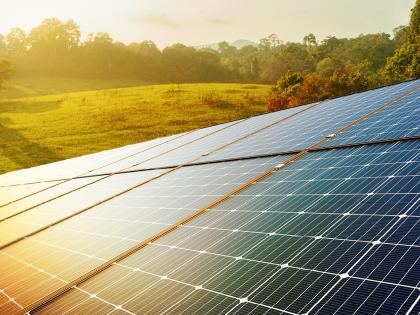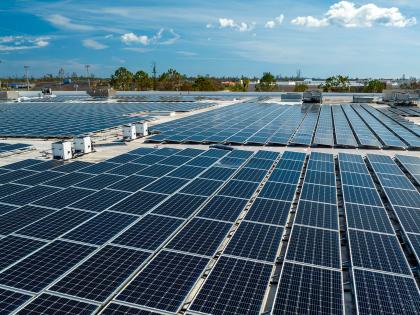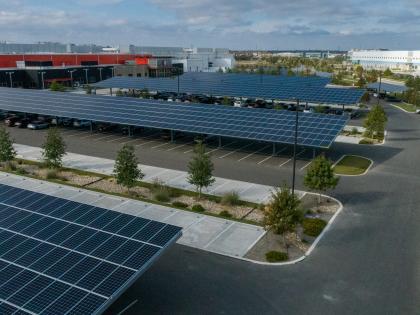Going Green for Earth Day
Four ways companies can make their commercial facilities more sustainable
Real estate is one of the biggest CO2 emitters, with buildings accounting for 30-34% of global energy consumption. This makes it a critical sector in the global effort to reduce carbon emissions and combat climate change. Fortunately, there are many solutions available to help reduce the carbon footprint of real estate, while also reducing energy costs, improving building safety and boosting operational efficiency.
With Earth Day around the corner, this article discusses several of the most impactful changes companies can implement to make their buildings more sustainable.
Install Solar Panels
One of the most effective sustainable upgrades for commercial facilities is the installation of solar panels to a roof or carport. Solar panels provide a clean source of energy and can help companies save on their cost of power. Additionally, companies may be able to receive renewable energy credits for offsetting carbon emissions depending on their location of operation.
Companies who install solar panels can minimize their carbon footprint and contribute to the wider goal of reducing greenhouse gas emissions. It can also help them achieve their corporate sustainability goals and align with the growing interest in ESG broadly among stakeholders, including investors, customers and employees.
Upgrade to LED Lighting
A simple step that companies can take to improve a building's sustainability is switching to light-emitting diode (LED) bulbs. LEDs produce light up to 90% more efficiently than other types of light bulbs, which can significantly reduce energy consumption. Additionally, LEDs do not need to be replaced as often as incandescent or fluorescent bulbs, lasting as long as 14 years in a building which uses lighting for approximately 10 hours each day.
LED lightbulbs are a more sustainable option not only due to their efficiency and longevity, but also because they do not have the environmentally hazardous materials incandescent bulbs contain (including argon and xenon gases). LED lights also give off very little heat compared to other types of lighting, therefore helping reduce a building’s temperature and limiting the power load on its mechanical systems.
The payback period for an LED retrofit is shorter than many other sustainable upgrades, making it a great starting point for companies looking to make their buildings more efficient.
Invest in Water Recycling
Climate change has caused water scarcity to become an increasing issue of concern. As a result, water recycling has emerged as a viable option to provide a sustainable source of water in commercial facilities.
A leading option for reducing water waste and preserving this vital resource is to recycle greywater. Greywater refers to lightly used water from sources such as sinks, showers and washing machines. Instead of directing this water into the sewer system, facilities can instead treat it and repurpose it for non-potable uses such as toilet flushing and irrigation. Instead of wasting freshwater, recycled water can be used when potable water is not needed.
By harnessing the latest technology, water recycling has the potential to revolutionize the way we manage water waste and conserve this precious resource. As water scarcity becomes an increasingly pressing issue, water recycling will be an important step companies can take to make their buildings more sustainable.
Utilize IoT Sensors
As businesses leverage technology to help them operate more sustainably, integrating Internet of Things (IoT) technology has proven valuable in helping companies manage building efficiency on a daily basis. In particular, IoT sensors can collect data and bridge the gap between the digital and the physical world, helping companies gather information on things like energy consumption, temperature, air quality and occupancy levels.
For instance, IoT sensor data can help promote sustainability by helping companies monitor energy consumption and manage power usage. IoT sensors can also be vital in helping continuously monitor particulate matter (PM) concentrations and other chemicals, gasses and contaminants in the air, allowing companies to take measures to improve occupational safety and reduce greenhouse gas emissions.
Lease Your Real Estate? Partner With Your Landlord!
Implementing sustainability initiatives can make a huge difference in reducing a building’s carbon footprint. Companies that lease their real estate may think implementing these changes isn’t possible, but that may not be the case. Leveraging their landlord relationship is a great way to explore options for sustainable building improvements.
W. P. Carey is a leading real estate investor with a portfolio of over 1,400 properties, and recently launched a suite of sustainability and efficiency offerings for its tenants. With no upfront costs, W. P. Carey can help tenants manage the implementation of sustainability projects such as solar, LED lighting and smart metering, which can save money, reduce carbon emissions and benefit the environment. Contact W. P. Carey today to learn more!
Related Topics:
You May Also Like:

The Future Is Green
As the real estate industry evolves, sustainability continues to be recognized as a key consideration shaping investment strategies, tenant expectations and development practices. From carbon-neutral...
Financing Sustainable Real Estate Through Sale-leasebacks
Financing sustainable building upgrades can be a daunting and expensive endeavor for many businesses. The upfront costs associated with sustainable materials, energy-efficient systems and eco-friendly...